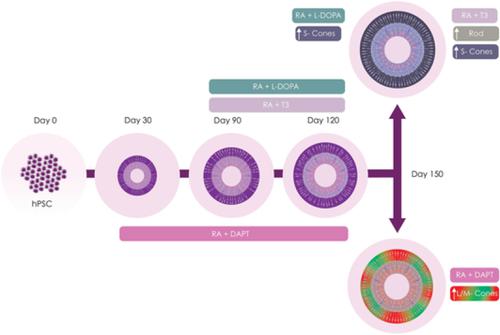当前位置:
X-MOL 学术
›
STEM CELLS
›
论文详情
Our official English website, www.x-mol.net, welcomes your
feedback! (Note: you will need to create a separate account there.)
Developing a simple method to enhance the generation of cone and rod photoreceptors in pluripotent stem cell-derived retinal organoids
STEM CELLS ( IF 4.0 ) Pub Date : 2019-10-31 , DOI: 10.1002/stem.3082 Darin Zerti 1 , Birthe Dorgau 1 , Majed Felemban 1, 2 , Ali E Ghareeb 1 , Min Yu 1 , Yuchun Ding 3 , Natalio Krasnogor 3 , Majlinda Lako 1
STEM CELLS ( IF 4.0 ) Pub Date : 2019-10-31 , DOI: 10.1002/stem.3082 Darin Zerti 1 , Birthe Dorgau 1 , Majed Felemban 1, 2 , Ali E Ghareeb 1 , Min Yu 1 , Yuchun Ding 3 , Natalio Krasnogor 3 , Majlinda Lako 1
Affiliation

|
Cell replacement therapy is a promising treatment for irreversible retinal cell death in diverse diseases such as Stargardt's disease, age‐related macular degeneration, and retinitis pigmentosa. The final impact of all retinal dystrophies is the loss of photoreceptors; hence, there is a pressing need for research into replacement. Seminal work has shown that a simple three‐dimensional culture system enables differentiation of human pluripotent stem cells to retinal organoids containing large numbers of photoreceptors developing alongside retinal neurons and Müller glia cells in a laminated structure that resembles the native retina. Despite these promising developments, current protocols show different efficiencies across pluripotent stem cells and result in retinal organoids with a mixture of photoreceptor cells at varying maturation states, along with nonphotoreceptor cell types. In this study, we investigated the impact of stage‐specific addition of retinoic acid (RA), 9‐cis‐retinal, 11‐cis‐retinal, levodopa (l‐DOPA), triiodothyronine (T3), and γ‐secretase inhibitor ((2S)‐N‐[(3,5‐Difluorophenyl)acetyl]‐l‐alanyl‐2‐phenyl]glycine1,1‐dimethylethyl ester2L [DAPT]) in the generation of cone and rod photoreceptors. Our results indicate that addition of RA + T3 during days 90 to 120 of differentiation enhanced the generation of rod and S‐cone photoreceptor formation, while the combined addition of DAPT from days 28 to 42 with RA during days 30 to 120 of differentiation led to enhanced generation of L/M‐cones at the expense of rods. l‐DOPA when added together with RA during days 90 to 120 of differentiation also promoted the emergence of S‐cones at the expense of rod photoreceptors. Collectively, these data represent an advance in our ability to direct generation of rod and cone photoreceptors in vitro.
中文翻译:

开发一种简单的方法来增强多能干细胞衍生的视网膜类器官中视锥细胞和视杆细胞的产生
细胞替代疗法是治疗斯塔加特氏病、年龄相关性黄斑变性和色素性视网膜炎等多种疾病中不可逆视网膜细胞死亡的一种很有前途的治疗方法。所有视网膜营养不良的最终影响是光感受器的丧失;因此,迫切需要对替代进行研究。开创性的工作表明,一个简单的三维培养系统可以使人类多能干细胞分化为含有大量光感受器的视网膜类器官,这些光感受器与视网膜神经元和 Müller 神经胶质细胞一起发育,形成类似于天然视网膜的层状结构。尽管取得了这些有希望的发展,但目前的方案显示出跨多能干细胞的不同效率,并导致视网膜类器官与不同成熟状态的光感受器细胞混合,以及非感光细胞类型。在这项研究中,我们调查了视黄酸 (RA)、9-顺式-视黄醛、11-顺式-视黄醛、左旋多巴 (l-DOPA)、三碘甲腺原氨酸 (T3) 和 γ-分泌酶抑制剂的阶段特异性添加的影响。 (2S)-N-[(3,5-二氟苯基)乙酰基]-l-丙氨酰-2-苯基]甘氨酸1,1-二甲基乙基酯2L [DAPT])在锥状和杆状光感受器的生成中。我们的结果表明,在分化的第 90 至 120 天期间添加 RA + T3 增强了视杆细胞和 S 锥光感受器的形成,而在第 28 至 42 天的 DAPT 与分化的第 30 至 120 天的 RA 联合添加导致以杆为代价增强 L/M 锥体的生成。在分化的第 90 天到第 120 天,将左旋多巴与 RA 一起添加时,也会以杆状光感受器为代价促进 S 锥体的出现。
更新日期:2019-10-31
中文翻译:

开发一种简单的方法来增强多能干细胞衍生的视网膜类器官中视锥细胞和视杆细胞的产生
细胞替代疗法是治疗斯塔加特氏病、年龄相关性黄斑变性和色素性视网膜炎等多种疾病中不可逆视网膜细胞死亡的一种很有前途的治疗方法。所有视网膜营养不良的最终影响是光感受器的丧失;因此,迫切需要对替代进行研究。开创性的工作表明,一个简单的三维培养系统可以使人类多能干细胞分化为含有大量光感受器的视网膜类器官,这些光感受器与视网膜神经元和 Müller 神经胶质细胞一起发育,形成类似于天然视网膜的层状结构。尽管取得了这些有希望的发展,但目前的方案显示出跨多能干细胞的不同效率,并导致视网膜类器官与不同成熟状态的光感受器细胞混合,以及非感光细胞类型。在这项研究中,我们调查了视黄酸 (RA)、9-顺式-视黄醛、11-顺式-视黄醛、左旋多巴 (l-DOPA)、三碘甲腺原氨酸 (T3) 和 γ-分泌酶抑制剂的阶段特异性添加的影响。 (2S)-N-[(3,5-二氟苯基)乙酰基]-l-丙氨酰-2-苯基]甘氨酸1,1-二甲基乙基酯2L [DAPT])在锥状和杆状光感受器的生成中。我们的结果表明,在分化的第 90 至 120 天期间添加 RA + T3 增强了视杆细胞和 S 锥光感受器的形成,而在第 28 至 42 天的 DAPT 与分化的第 30 至 120 天的 RA 联合添加导致以杆为代价增强 L/M 锥体的生成。在分化的第 90 天到第 120 天,将左旋多巴与 RA 一起添加时,也会以杆状光感受器为代价促进 S 锥体的出现。











































 京公网安备 11010802027423号
京公网安备 11010802027423号